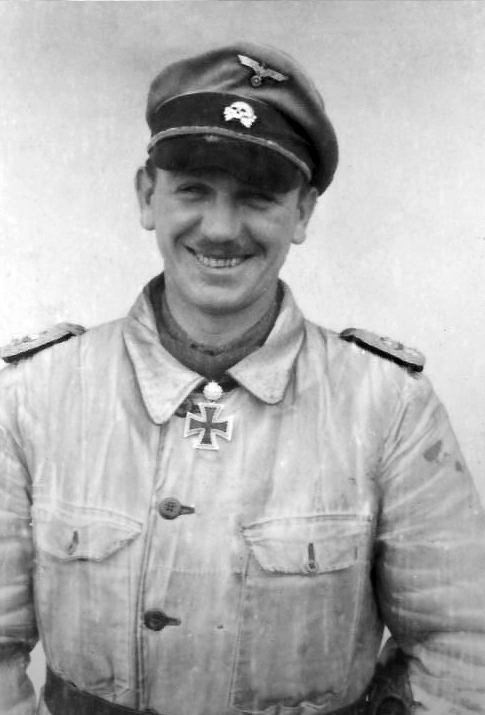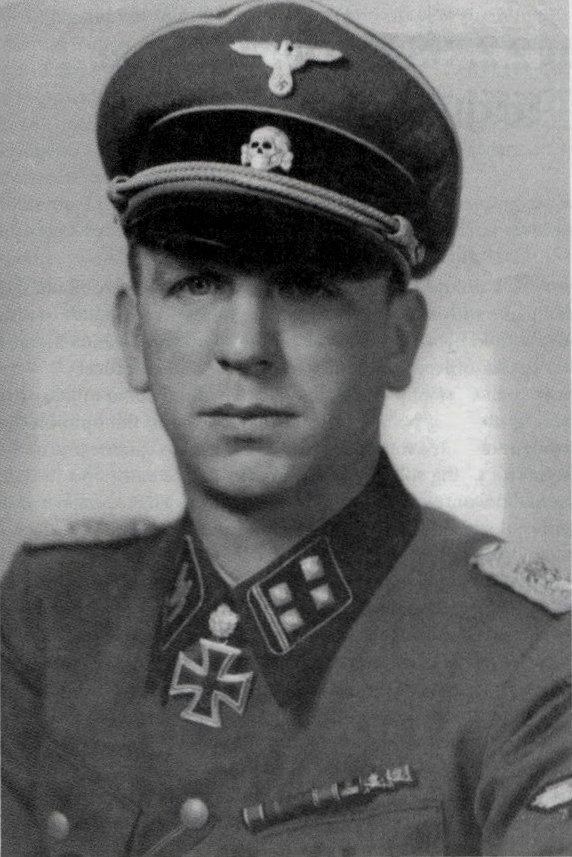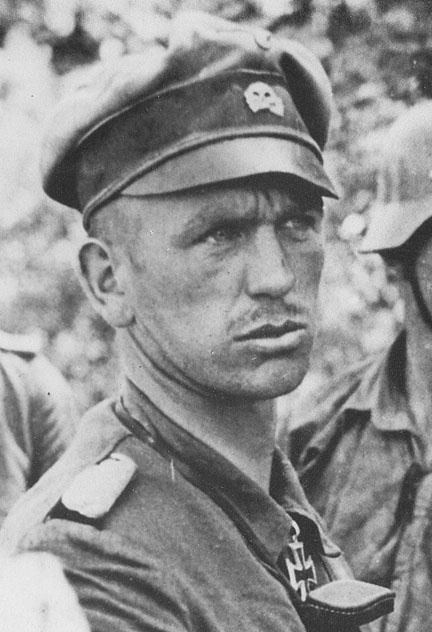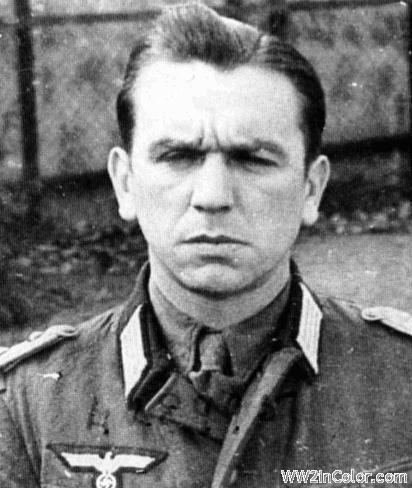Nickname(s) Panzer Meyer Years of service 1930–45 | Name Kurt Meyer | |
 | ||
Service number NSDAP #316,714SS #17,559 Commands held 14th Anti Tank Company LSSAH15th Motor Cycle Company LSSAH1st SS Reconnaissance Battalion LSSAHSS Panzer Grenadier Regiment 2512th SS Panzer Division Hitlerjugend Books Grenadiers: The Story of Waffen SS General Kurt "Panzer" Meyer Similar People Sepp Dietrich, Joachim Peiper, Wilhelm Bittrich, Guy Simonds, Gunther von Kluge Died 23 December 1961 (aged 51) Hagen, North Rhine-Westphalia, West Germany Nationality German Children Kurt Meyer Jr. | ||
Kurt Meyer (23 December 1910 – 23 December 1961) was a high-ranking member in the Waffen-SS of Nazi Germany who commanded SS Division Hitlerjugend during World War II. He participated in the Battle of France, Operation Barbarossa, and the Battle of Normandy, among others, and was a recipient of the Knight's Cross of the Iron Cross with Oak Leaves and Swords.
Contents
- Kurt Meyer Part 3 Workbench Wednesday Oct 23
- The Life of Kurt Meyer English
- Career in the SS
- Massacre of civilians
- Battle of Normandy and Falaise pocket
- As POW under Allied surveillance
- War crimes trial
- Indictment
- Proceedings
- Sentence
- Activities within HIAG
- Awards
- References

Meyer was convicted of war crimes for his role in the Ardenne Abbey massacre, the killing of Canadian prisoners of war in Normandy. He was sentenced to death; the sentence was later commuted to life in prison. Meyer was one of the last German war criminals to be released from prison.

After his release, Meyer became active in HIAG, a revisionist organisation and lobby group of former high-ranking Waffen-SS men. He was described by historians as a leading Waffen-SS apologist and the organisation's most effective spokesperson, depicting the majority of the Waffen-SS as apolitical, recklessly brave fighters, who were not involved in the crimes of the Nazi regime.

Kurt Meyer Part 3, Workbench Wednesday Oct 23
The Life of Kurt Meyer (English)
Career in the SS

Born in 1910, Kurt Meyer came from a lower-class family. In 1914, his father joined the army and served as an NCO in World War I. Meyer joined the Nazi Party in September 1930 and the SS in October 1931. In May 1934, he was posted to the Leibstandarte SS Adolf Hitler (LSSAH). In September 1936, Meyer was promoted to SS-Obersturmführer, and appointed to command the LSSAH's anti-tank unit. With the LSSAH, Meyer took part in the annexation of Austria and in the occupation of Czechoslovakia.

With the LSSAH, Meyer participated in the invasion of Poland and was awarded the Iron Cross, second class, on 20 September 1939. Near Modlin, in October, Meyer was alleged to have ordered the shooting of fifty Polish Jews as reprisals, and to have court-martialled a platoon commander who refused to carry out his instructions. After the Battle of France, Meyer was awarded the Iron Cross, first class.
Following the Battle of France, Meyer's company was reorganized into the LSSAH's Reconnaissance Battalion and Meyer was promoted to SS-Sturmbannführer. Benito Mussolini's less than successful invasion of Greece prompted Germany to invade Yugoslavia and Greece. In Greece, Meyer's detachment was tasked with cutting off the Greek III Corps, retreating from Albania. Beginning on 13 April, Meyer's reconnaissance battalion attacked the Kleisoura Pass, south-west of Vevi and despite stiff resistance from the Greek 20th Division, the German forces captured the pass in what later became known as the Battle of Kleisoura Pass. With the road now open, the German forces drove through to the Kastoria area to cut off retreating Greek and British Commonwealth forces. Afterwards, Meyer was awarded the Knight's Cross of the Iron Cross. The division, including Meyer and his battalion participated in the Operation Barbarossa as a part of Army Group South in June 1941. In 1942 he was awarded the German Cross in gold.
Massacre of civilians
In early 1942, his battalion participated in the Second Battle of Kharkov. Meyer was reported to have ordered the destruction of a village during the fighting around Kharkov and the murder of all its inhabitants. After the war, Obersturmfuhrer Erich Rumpf described an incident that took place on Meyer's orders in the village of Yefremovka (Jefremowka) during the fighting south of Kharkov in March 1943. Billeted in the village, Rumpf heard a pistol shot at 10:30 a.m. in front of the house where he was staying. He ran to the door and saw a Hauptsturmfuhrer (captain) who angrily demanded that the company commander be summoned. Shortly Hauptsturmfuhrer Nueske arrived on the scene to have the SS captain shout once more, "On the orders of Meyer, this town is to be leveled to the ground, because this morning armed civilians attacked this locality. At this he shot a 25-year old woman who was busy cooking our lunch". Later Rumpf heard other shots and learned that the same man shot two other girls in the house nearby. Nueske stormed off, only to return 30 minutes later to confirm Meyer's orders. According to Rumpf, the Waffen-SS men killed all the village inhabitants and burned their homes to the ground.
Not only were there Russian witnesses, but a separate testimony from captured SS-Sturmbannfuhrer Jacob Hanreich (given to the Western Allies interrogators after his capture in France in 1944) substantiates elements of the story:
The reconnaissance battalion of the LSSAH made an advance at the end of February [1943] towards the East and reached the village of Jefremowka. There they were surrounded by Russian forces. Fuel and ammo ran out and they were supplied by air until they were ordered to break through towards the West. Before trying to do so, the entire civilian population was shot and the village burnt to the ground. The battalion at that time was led by Kurt Meyer.
Ukrainian sources, including surviving witness Ivan Kiselev who was 14 at the time of the massacre, report that the killings took place on 17 February 1943. On 12 February, troops of the LSSAH occupied two villages, Yefremovka and Semyonovka. Retreating Soviet forces had wounded two SS officers. In retaliation, five days later LSSAH troops killed 872 men, women and children. Some 240 of these were burned alive in the church of Yefremovka. Russian sources claim that the massacre was perpetrated by the "Blowtorch Battalion" led by Jochen Peiper.
Battle of Normandy and Falaise pocket
Meyer was appointed to command a regiment in the newly activated and still-forming SS Division Hitlerjugend. On 6 June 1944, the Allies launched Operation Overlord, the amphibious invasion of France. After much confusion, the division got moving at around 1430 on 6 June, and several units advanced on Sword Beach, until they were halted by naval and anti-tank fire, and by Allied air cover. During the evening of 7 June, elements of the division under Meyer's command committed the Ardenne Abbey massacre: 11 Canadian prisoners of war, soldiers from the North Nova Scotia Highlanders and the 27th Armoured Regiment (The Sherbrooke Fusilier Regiment), were shot in the back of the head.
By 2200 on 7 June, Meyer set up his command post in Ardenne Abbey. While the division was ordered to break through to the beach, Meyer ordered his regiment to take covering positions during 7 June and await reinforcements. The Canadian Official History described his personal involvement in the battle:
Although Meyer claimed later that only shortage of petrol and ammunition prevented him from carrying the attack on towards the coast, this need not be taken seriously. Indeed, he himself testified that, seeing from his lofty perch "enemy movements deeper in that area"—doubtless the advance of the main body of the 9th Brigade—he came down and rode his motorcycle to the 3rd Battalion to order its C.O. "not to continue the attack north of Buron". Meyer's 2nd Battalion had been drawn into the fight, north of St. Contest "in the direction of Galmanche". Fierce fighting was going on when Meyer visited the battalion in the early evening; just as he arrived the battalion commander's head was taken off by a tank shot... Meyer ordered both this battalion and the 1st (around Cambes) to go "over from attack to defense."
The 27th Canadian Armoured Regiment reported 31 German tanks destroyed during this engagement, and German casualties were serious enough to halt the SS short of their objective of pushing back the Allies to the sea. Over the next two weeks, the regiment suffered heavy casualties in the battles for Carpiquet Aérodrome and the villages of Contest, Buron, and Authie. On 14 June, SS-Brigadeführer Fritz Witt, commander of the division, was killed when a naval barrage hit his command post. Meyer, as the next highest-ranking officer, was promoted to divisional commander; at 33 years of age, he was one of the youngest German divisional commander of the war. By 4 July, the division was reduced to a weak battlegroup. On the 10th, the division retreated behind the Orne River. In just over one month of fighting, it had sustained more than 60 percent casualties.
The Canadian forces began their advance on Falaise, planning to meet up with the Americans behind the German lines, with the goal of encircling and destroying the German divisions around Caen. The Hitlerjugend was holding the northern point of what became known as the Falaise pocket. After several days fighting, Meyer's unit was reduced to about 1,500 men. He led his men in an attempt to break out of the pocket. Meyer described the conditions in the pocket in his memoirs: "Concentrated in such a confined space, we offer unique targets for the enemy air power. [...] Death shadows us at every step. Meyer made it out of the Falaise pocket and the remnants of the Hitlerjugend joined the retreat across the Seine River and into Belgium. On 27 August, he was awarded the Swords to the Knight's Cross with Oak Leaves. On 6 September 1944, he was captured by the Belgian partisans and handed over to the American forces.
As POW under Allied surveillance
Upon his capture, as a high-ranking officer, Meyer was interned at Trent Park in England, where his conversations with the other prisoners of war of senior rank were covertly audio-taped by the British military intelligence. He was quite frank about his political orientation in these exchanges, revealing that he had adopted National Socialism like a religion, and dedicated himself to its ideology, saying that a person "could only give his heart once in life". Throughout the covert surveillance recordings Meyer and other SS-men confirmed the Wehrmacht officers' views of them as ideological fanatics with an almost religious belief in Nazism and its Third Reich, and the messianic personality cult of Adolf Hitler as its Fuhrer.
In a taped conversation from January 1945 Meyer praised Hitler for having inspired a "tremendous awakening in the German people" and for giving them back their self-confidence. In another taped conversation made in February 1945, when he encountered a demoralized Wehrmacht general, Meyer chided him: "I wish a lot of the officers here could command my division, so that they might learn some inkling of self-sacrifice and fanaticism." According to the evidence revealed by these audio recordings, Meyer had not just paid lip-service to Nazi ideology to further his military career, he saw himself as the definition of an ideological racial warrior, whose duty it was to inculcate the men he had led in action with the National Socialist creed.
War crimes trial
Meyer was held as a prisoner of war until December 1945, when in the town of Aurich in Germany he was put on trial for war crimes, charged with the murder of unarmed Allied prisoners of war in Normandy.
Indictment
The charges were that:
- Prior to 7 June 1944, Meyer had incited troops under his command to deny quarter to surrendering Allied soldiers.
- On or around 7 June 1944, Meyer was responsible for his troops killing twenty-three prisoners of war at Buron and Authie.
- On or around 8 June 1944, Meyer ordered his troops to kill seven prisoners of war at his headquarters at the Abbaye Ardenne.
- On or around 8 June 1944, Meyer was responsible for his troops killing seven prisoners of war, as above.
- On or around 8 June 1944, Meyer was responsible for his troops killing eleven prisoners of war, as above.
The third and fourth charges referred to the same event; the fourth charge was provided as an alternative to the third, in case the killings were found to be a war crime but he was not found to have ordered them. The fifth charge related to a separate group of prisoners; in this case, the prosecution did not allege he had directly ordered their deaths. In total, Meyer was charged with the responsibility for the deaths of twenty-three prisoners on 7 June, and eighteen more on 8 June. He pleaded not guilty to all five charges.
A second charge sheet, which accused him of responsibility for the death of seven Canadian prisoners of war at Mouen on 8 June 1944, was prepared but, after the successful conclusion of the first trial, it was decided not to try the second set of charges. No charges were laid against him regarding allegations of previous war crimes in Poland or in the Ukraine; the Canadian court was constituted only to deal with crimes committed against Canadian nationals.
Proceedings
The court was the first major Canadian war crimes trial, and faced a number of hurdles before it could be convened. Chief among these was the fact that, as the accused was a general, he had to be tried by soldiers of equal rank, and finding sufficient Canadian generals able to sit was difficult. The court, as eventually constituted, had four brigadiers – one, Ian Johnston, a lawyer in civilian life – and was presided over by Major General H. W. Foster, former commander of the 7th Canadian Infantry Brigade in Normandy.
Following eyewitness statements by both German and Canadian soldiers, as well as French civilians, the trial found Meyer guilty of the first, fourth and fifth charges, but acquitted of the second and third. This meant that he was deemed guilty of inciting his troops to give no quarter to the enemy, and of the responsibility for his troops killing eighteen prisoners at the Abbaye Ardenne, but not responsible for the killings of twenty-three at Buron and Authie; whilst he was held responsible for the deaths at the Abbaye Ardenne, he was acquitted of directly ordering the killings. In Meyer's closing statement before sentencing, he chose not to ask for clemency, but instead defended the record of his unit and the innocence of his soldiers, and closed by saying that "by the Canadian Army I was treated as a soldier and that the proceedings were fairly conducted."
Sentence
While most observers expected a sentence of some years imprisonment – the court had not found him guilty of directly ordering the murders, but merely of tacitly condoning them – the court sentenced Meyer to death; one of the five judges, Bell-Irving, later commented that he believed a guilty sentence required the death penalty and that no lesser sentence was permissible. The sentence was subject to confirmation by higher command, and while Meyer was originally willing to accept it, he was persuaded by his wife and by his defence counsel to appeal. The appeal was reviewed by Canadian headquarters and dismissed by Major-General Christopher Vokes, the official convening authority for the court, who noted that he could not see a clear way to mitigate the sentence imposed by the court.
However, shortly before the sentence was to be carried out, the prosecutor realised that the trial regulations contained a section allowing for a final appeal to "the senior combatant officer in the theatre", and on making enquiries found that no-one had completed such a review. The execution was postponed until a review could be carried out; somewhat oddly, the senior officer was found to be the commander of Canadian forces in Europe, the same Christopher Vokes who had just dismissed Meyer's appeal. Vokes had second thoughts, and began a series of meetings with senior officials to discuss how he should proceed. Vokes' main concern was the degree to which a commander should be held responsible for the actions of his men. The consensus which emerged from the discussions was that death was an appropriate sentence only when "the offence was conclusively shown to have resulted from the direct act of the commander or by his omission to act." Vokes conceded that "there isn't a general or colonel on the Allied side that I know of who hasn't said, 'Well, this time we don't want any prisoners'"; indeed, he himself had ordered the shooting of two prisoners in 1943 before his divisional commander intervened.
After his deliberations, Vokes commuted the sentence to one of life imprisonment, stating that he felt Meyer's level of responsibility for the crimes did not warrant the death penalty. Following his reprieve, a Communist-operated German newspaper reported that the Soviet Union was considering putting Meyer on trial for alleged war crimes committed at Kharkov. However, little more was heard of this, and in April, Meyer was transported to Canada to begin his sentence. Meyer served five years in Dorchester Penitentiary, in New Brunswick, Canada where he worked in the library and learned English.
Meyer petitioned for clemency in late 1950 – somewhat surprisingly including an offer to serve in a Canadian or United Nations military force if released; the government was willing to let him return to a German prison but not to release him outright. He was transferred to a British military prison in Werl, West Germany in 1951. He was released from prison on 7 September 1954 after the German government reduced his sentence to fourteen years and for good behavior, was determined to be eligible for release. Upon his return to Germany in 1951, Meyer told a reporter that nationalism was past and that "a united Europe is now the only answer".
Activities within HIAG
Upon his release from prison, Meyer became active in HIAG, the Waffen-SS lobby group, formed in 1951 by former high-ranking Waffen-SS men, including Paul Hausser, Felix Steiner and Herbert Gille. Meyer became the organization's spokesperson in 1959. He was considered one of the leading Waffen-SS apologists. At a HIAG rally in 1957, he announced that while he stood behind his old commanders, Hitler had made many mistakes and it was now time to look to the future, not to the past. Speaking before some 8000 SS men at the HIAG convention in Karlsberg, Bavaria, in 1957, he proclaimed that "SS troops committed no crimes, except the massacre at Oradour, and that was the action of a single man". He insisted that the Waffen-SS was "as much a regular army outfit as any other in the Wehrmacht."
His memoirs, Grenadiere (1957), were published as part of this campaign and were a glorification of the SS's part in the war as well as of his role in it. The book detailed his exploits at the front and served as an element of the Waffen-SS rehabilitation efforts. Meyer condemned the "inhuman suffering" that the Waffen-SS personnel had been subjected to "for crimes which they neither committed, nor were able to prevent". Historian Charles W. Sydnor referred to Grenadiere as "perhaps the boldest and most truculent of the apologist works". The book was part of HIAG's propaganda campaign to promote the perceptions of the Waffen-SS in popular culture as apolitical, recklessly brave fighters who were not involved in the war crimes of the Nazi regime. These notions have since been refuted by historians.
In his later years he was afflicted with poor health, needing a stick to walk, and suffering from heart and kidney disease. After a series of mild strokes, he died of a heart attack in Hagen, Westphalia, on 23 December 1961. Fifteen thousand people attended his funeral in Hagen, a cushion-bearer carrying his medals in the cortege.
